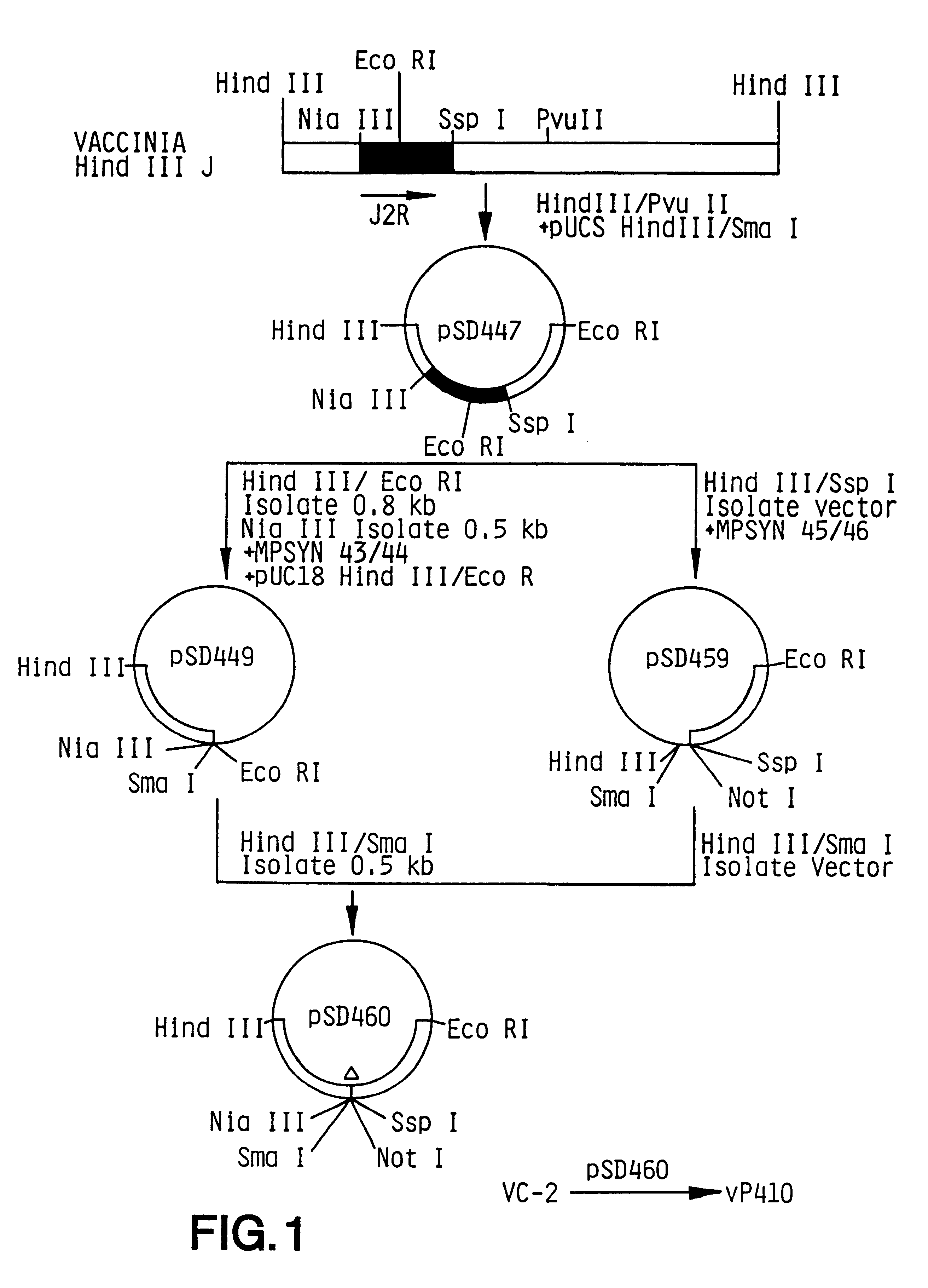Pox virus containing DNA encoding a cytokine and/or a tumor associated antigen
a technology of cytokine and tumor, which is applied in the field of pox virus containing dna encoding a cytokine and/or a tumor associated antigen, can solve the problems of compromising the ability of the virus to grow on serum starved cells, lack of significant pathogenic properties, and inactivation or complete deletion of the thymidine kinase gene, etc., to achieve the effect of enhancing safety
- Summary
- Abstract
- Description
- Claims
- Application Information
AI Technical Summary
Benefits of technology
Problems solved by technology
Method used
Image
Examples
example 1
CONSTRUCTION OF PLASMID pSD460 FOR DELETION OF THYMIDINE KINASE GENE (J2R)
Referring now to FIG. 1, plasmid pSD406 contains vaccinia HindIII J (pos. 83359-88377) cloned into pUC8. pSD406 was cut with HindIII and PvuII, and the 1.7 kb fragment from the left side of HindIII J cloned into pUC8 cut with HindIII / SmaI, forming pSD447. pSD447 contains the entire gene for J2R (pos. 83855-84385). The initiation codon is contained within an NlaIII site and the termination codon is contained within an SspI site. Direction of transcription is indicated by an arrow in FIG. 1.
To obtain a left flanking arm, a 0.8 kb HindIII / EcoRI fragment was isolated from pSD447, then digested with NlaIII and a 0.5 kb HindIII / NlaIII fragment isolated. Annealed synthetic oligonucleotides MPSYN43 / MPSYN44 (SEQ ID NO:1 / SEQ ID NO:2)
were ligated with the 0.5 kb HindIII / NlaIII fragment into pUC18 vector plasmid cut with HindIII / EcoRI, generating plasmid pSD449.
To obtain a restriction fragment containing a vaccinia right ...
example 2
CONSTRUCTION OF PLASMID pSD486 FOR DELETION OF HEMORRHAGIC REGION (B13R+B14R)
Referring now to FIG. 2, plasmid pSD419 contains vaccinia SalI G (pos. 160,744-173,351) cloned into pUC8. pSD422 contains the contiguous vaccinia SalI fragment to the right, SalI J (pos. 173,351-182,746) cloned into pUC8. To construct a plasmid deleted for the hemorrhagic region, u, B13R-B14R (pos. 172,549-173,552), pSD419 was used as the source for the left flanking arm and pSD422 was used as the source of the right flanking arm. The direction of transcription for the u region is indicated by an arrow in FIG. 2.
To remove unwanted sequences from pSD419, sequences to the left of the NcoI site (pos. 172,253) were removed by digestion of pSD419 with NcoI / SmaI followed by blunt ending with Klenow fragment of E. coli polymerase and ligation generating plasmid pSD476. A vaccinia right flanking arm was obtained by digestion of pSD422 with HpaI at the termination codon of B14R and by digestion with NruI 0.3 kb to t...
example 3
CONSTRUCTION OF PLASMID pMP494.DELTA. FOR DELETION OF ATI REGION (A26L)
Referring now to FIG. 3, pSD414 contains SalI B cloned into pUC8. To remove unwanted DNA sequences to the left of the A26L region, pSD414 was cut with XbaI within vaccinia sequences (pos. 137,079) and with HindIII at the pUC / vaccinia junction, then blunt ended with Klenow fragment of E. coli polymerase and ligated, resulting in plasmid pSD483. To remove unwanted vaccinia DNA sequences to the right of the A26L region, pSD483 was cut with EcoRI (pos. 140,665 and at the pUC / vaccinia junction) and ligated, forming plasmid pSD484. To remove the A26L coding region, pSD484 was cut with NdeI (partial) slightly upstream from the A26L ORF (pos. 139,004) and with HpaI (pos. 137,889) slightly downstream from the A26L ORF. The 5.2 kb vector fragment was isolated and ligated with annealed synthetic oligonucleotides ATI3 / ATI4 (SEQ ID NO:12 / SEQ ID NO:13)
reconstructing the region upstream from A26L and replacing the A26L ORF with...
PUM
| Property | Measurement | Unit |
|---|---|---|
| apparent molecular weights | aaaaa | aaaaa |
| apparent molecular weights | aaaaa | aaaaa |
| temperature | aaaaa | aaaaa |
Abstract
Description
Claims
Application Information
 Login to View More
Login to View More - R&D
- Intellectual Property
- Life Sciences
- Materials
- Tech Scout
- Unparalleled Data Quality
- Higher Quality Content
- 60% Fewer Hallucinations
Browse by: Latest US Patents, China's latest patents, Technical Efficacy Thesaurus, Application Domain, Technology Topic, Popular Technical Reports.
© 2025 PatSnap. All rights reserved.Legal|Privacy policy|Modern Slavery Act Transparency Statement|Sitemap|About US| Contact US: help@patsnap.com



